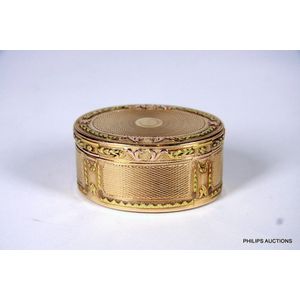French 18ct Gold Three-Coloured Snuff Box, 1800
A fine French three coloured 18 carat gold snuff box, circa 1800, mark B&M with crown to the interior, gold punch marks, an oval hinged box of engine turned design, with neoclassical borders and trims in contrasting rose and 'Green' gold; gold marks to interior rim, gold weight 58gr, height 3 cm, length 5.5 cm, width 4.5 cm
You must be a subscriber, and be logged in to view price and dealer details.
Subscribe Now to view actual auction price for this item
When you subscribe, you have the option of setting the currency in which to display prices to $Au, $US, $NZ or Stg.
This item has been sold, and the description, image and price are for reference purposes only.
- Carat - A carat (abbreviated "ct") is a unit of measurement used to describe the weight of a diamond or other gemstone, and separately is a unit of measurement used to describe the weight of precious metals such as gold,.
For gemstones, one carat is equal to 0.2 grams or 200 milligrams. The weight of a diamond is one of the Four Cs (along with cut, colour, and clarity) that are used to determine a diamond's value.
It is important to note that a diamond's weight does not necessarily correspond to its size. A diamond's cut, which affects how well it reflects light, can make a diamond of a lower weight appear larger than a diamond of a higher weight. Additionally, the carat is not the only factor to determine the value of a diamond, other factors such as clarity, colour and cut are important too.
In the gold industry, the purity of gold is measured in carats (abbreviated "ct"), with 24 karats being pure gold and lower carat numbers indicating a lower purity level. So, for example, 18 carat gold is 18/24 or 75% pure gold, and 12 carat gold is 12/24 or 50% pure gold. - Engine Turned - Engine turning is a decorative technique used on metal surfaces to create intricate curving or geometric pattern. The process involves cutting a series of lines into the surface of the metal using a rose engine or decoration lathe which rotates the metal as it cuts, allowing the operator to create a repeating pattern that covers the entire surface. The resulting surface has a shimmering, reflective quality that is often described as "engine turned." Where an engine turned item has been enamelled, the term used to describe the decoration is usually guilloche.
Engine turning was originally developed to decorate metal objects such as firearms, scientific instruments, and other metal objects that required precise and elegant design. - Circa - A Latin term meaning 'about', often used in the antique trade to give an approximate date for the piece, usually considered to be five years on either side of the circa year. Thus, circa 1900 means the piece was made about 1900, probably between 1895 and 1905. The expression is sometimes abbreviated to c.1900.
This item has been included into following indexes:
Visually similar items

An Australian silver cylinder match case with revolving cover, rope edge and steel strike-plate. Height 3.2 cm
Sold by
in
for
You can display prices in $Au, $US, $NZ or Stg.

Silver trinket box, London, 1901
Sold by
in
for
You can display prices in $Au, $US, $NZ or Stg.

A pair of sterling silver pierced salts having blue glass insert
Sold by
in
for
You can display prices in $Au, $US, $NZ or Stg.

18ct 61stone diamond modern band ring three rows of pave set diamonds, gallery diamonds on wide plain band, round brilliant cuts approx 1.77cts TDW '12
Sold by
in
for
You can display prices in $Au, $US, $NZ or Stg.
